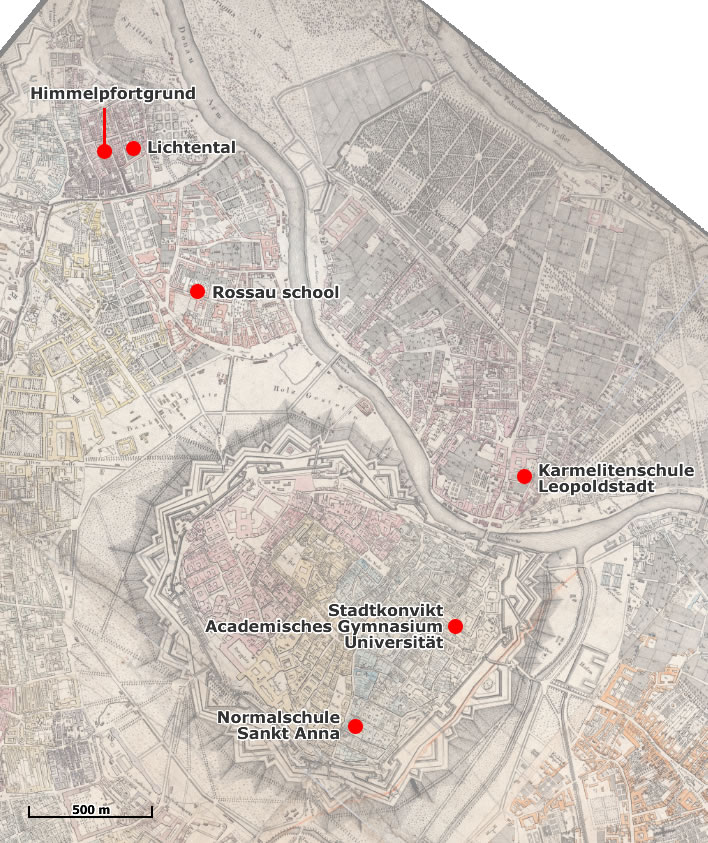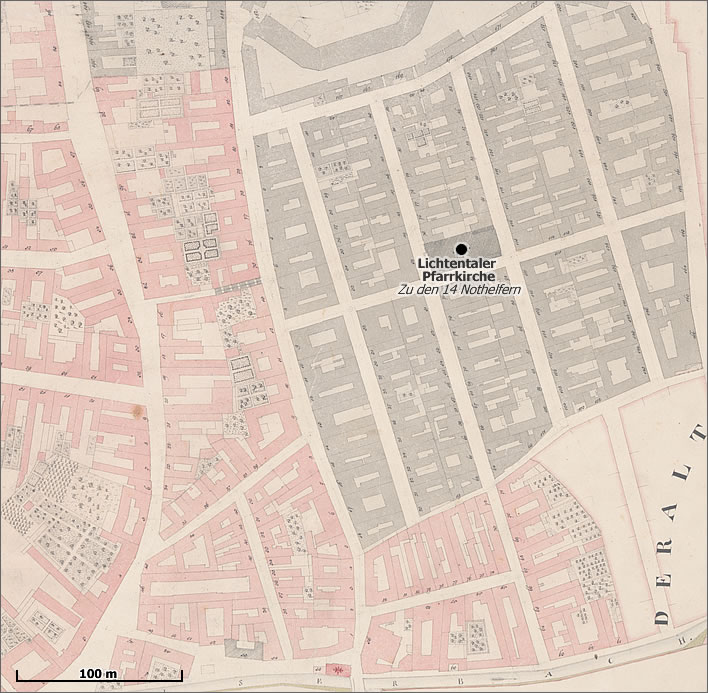Schubert in da hood
Posted by Richard on UTC 2020-07-08 14:24
Growing up in Himmelpfortgrund and Lichtental
Let's start with a platitude and hope that things improve from there: the childhood years are the most formative period of a person's life.
Normally we only get to know about this period when the child grows up and writes an autobiography. Parents don't seem to write about their children – having raised the brats for a couple of decades, few parents can find it in them to revisit that experience analytically.
Apart from our knowledge of the measures taken to get him an excellent secondary education at the expense of the Emperor, we know nothing of Franz Schubert's childhood years. He never wrote an autobiography. That must be the great 'if only…' wish of Schubert studies: just imagine how much deeper our understanding would be if on one of his summer breaks during the 1820s he had buckled down to write an account of his life instead of entertaining his hosts and composing even more music that would never find a publisher in his lifetime.
When his friends and acquaintances from adulthood wrote their brief memoirs of him his juvenile life was almost completely neglected. His brothers left a few nondescript remarks about their family life, remarks which are more a testament to their own mediocre minds than illuminating insights into the childhood of a genius.
None of the members of the 'Circles of Friends' knew anything directly of his childhood or his family life. For six years from age eleven onwards some got to know him in term time as a fellow boarder in the Stadtkonvikt; out of term they would all scatter back to their homes, homes which would not be in the comparatively poor suburb of Lichtental.
Conversely, no one who knew him in his childhood wrote anything about him. No former schoolfriends in Lichtental wrote about 'The Schubert I Knew'. They probably knew nothing about his genius anyway, for, outside the circle of the musically cultivated, Franz Peter Schubert was a nonentity throughout his life and for decades after his death.
Many of the things that fascinate us two centuries later are just those everyday conditions which contemporaries took for granted, imagining them to be barely worth mentioning. His first biographers wrote over half a century after that childhood, when nearly everyone concerned was long dead and this period had passed beyond recovery.
'Passed beyond recovery' – well, not quite, since some dogged archival research in the last twenty or thirty years has allowed us to glue some of the fragments of the artefact of his young life back together again in a convincing form. There are still many fragments missing, though, and we may never have a pot that holds water.
For orientation
Readers who are unfamiliar with Vienna might find an overview of the main locations in this part of the Schubert biography useful. Here are those locations marked on a town plan of Vienna from 1812.

Overview: the principal Schubert-related locations 1775~1820. Image: Stadtplan, Wien und Vorstädte (1812) [Detail]. ©ViennaGIS/FoS
We can see that the Innere Stadt is ringed by fortified walls. Outside of those are the Vorstädte, the suburbs, which are also shielded by an extended defensive wall (mostly not visible in this detail view). Unlike most cities, which grow outwards in a continuum, Vienna's outer districts remained for a long time separated from the inner city, allowing the suburbs to retain the character of small towns or villages.
Of course modernity, roads and transport systems have put an end to all that, meaning that today the visitor will not find it easy to visualise the city as it was in Schubert's time.
Until he was eleven Franz Peter Schubert was no city boy but grew up in the neighbouring suburbs of Himmelpfortgrund and Lichtental. After that his secondary education took him to the Innere Stadt, which is where most of his short adult life was spent.
Franz Peter's immediate ancestors began their lives in Vienna in the suburb of Leopoldstadt. His uncle Karl Schubert resettled there from his farming village in Moravia. There he acquired a widow with a Carmelite school attached. His younger brother, Franz Theodor, the future father of the composer, joined him a few years later.
Towards the completion of his service as an assistant teacher in his brother's school, Franz Theodor and his future wife moved to Lichtental. A short while later he acquired the post of teacher at the elementary school in Himmelpfortgrund, which is where his musical genius son grew up.
After 15 years there, Franz Theodor moved his school to another building in Himmelpfortgrund. Seven years after that he took over the newly rebuilt school in the nearby suburb of Rossau.
All in all, Franz Theodor Schubert and his family spent nearly a quarter of a century in the communities of Himmelpfortgrund and Lichtental.
The Gate of Heaven

Himmelpfortgrund (pink) and Lichtental (grey). Image: Stadtplan, Anton Behsel (1820-1825), Thury, Lichtenthal 1821. ©ViennaGIS/FoS.
The suburbs of Himmelpfortgrund and Lichtental are adjacent, but separated by a topographical quirk: Himmelpfortgrund stands on an elevated terrace, which rises above the Lichtental plain left behind by the Danube.
The 'Obere Hauptstrasse' (now the Nussdorfer Strasse, far left) runs roughly north-south upon the terrace; the 'Untere Hauptstrasse' (now the Liechtensteinstrasse) just to the east runs at the base of the terrace, along the margin of the Lichtental plain.
The two main routes were connected by Stiegen, 'steps', one of which is distinctly marked as such on the plan (left middle). Seen from Lichtental, especially after a few glasses of something or other, the terrace of the Himmelpfortgrund might easily seem like the 'ground of the Gate of Heaven' to the local wits.
A glance at the plan and then a glance at the scale indicator will show just how packed the living conditions were in these suburbs; a longer glance will reveal that most of the buildings had a central courtyard, which functioned as the lungs of the building.
Zoned out
A further characteristic is not immediately obvious on the map. Moderns are used to the concept of zone planning, where people live together in residential areas but work somewhere else; that 'somewhere else' in turn is usually divided up into more zones – trades, offices, industry and so on. In Himmelpfortgrund and Lichtental in Schubert's time there was no zoning at all: people resided on or next to their businesses – or, in the case of the Schuberts, over or next to their schools.
Large-scale industrialisation was yet to come, but there was already substantial manufacturing activity employing dozens of workers embedded in this urban patchwork.
The School Directive of 1774 foresaw this situation: schoolrooms may not form part of the domestic living area and lessons must not be disturbed by household activities or servants.
Chapters
Sources
This group of articles uses research from many different sources. In order to maintain readability in these long articles, these sources have not been cited directly.
All translations ©FoS.
| Dok | Deutsch, Otto Erich, ed. Schubert: Die Dokumente Seines Lebens. Erw. Nachdruck der 2. Aufl. Wiesbaden: Breitkopf & Härtel, 1996. [DE] |
| Erinn | —, ed. Schubert: Die Erinnerungen Seiner Freunde. Wiesbaden: Breitkopf & Härtel, 1997. [DE] |
0 Comments UTC Loaded:
Input rules for comments: No HTML, no images. Comments can be nested to a depth of eight. Surround a long quotation with curly braces: {blockquote}. Well-formed URLs will be rendered as links automatically. Do not click on links unless you are confident that they are safe. You have been warned!